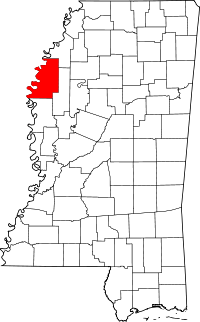Bolivar, Mississippi
| Bolivar, Mississippi | |
|---|---|
| Unincorporated community | |
 Bolivar, Mississippi  Bolivar, Mississippi | |
| Coordinates: 33°39′35″N 91°03′11″W / 33.65972°N 91.05306°WCoordinates: 33°39′35″N 91°03′11″W / 33.65972°N 91.05306°W | |
| Country | United States |
| State | Mississippi |
| County | Bolivar |
| Elevation | 141 ft (43 m) |
| Time zone | Central (CST) (UTC-6) |
| • Summer (DST) | CDT (UTC-5) |
| ZIP code | 38725 |
| GNIS feature ID | 667408[1] |
Bolivar is an unincorporated community in Bolivar County, Mississippi.
Bolivar was once the county seat, and Bolivar Landing was its port on the Mississippi River. Now permanently cut off from the river, Bolivar is a quiescent residential hamlet, while Bolivar Landing, immediately north and across the immense Mississippi Levee, is a cottage community on Lake Whittington.
History
When Bolivar County was established in 1836, the first county seat was located at Bolivar. William Vick sold 5 acres (2.0 ha) of land to the county for $800, and it was then named Bolivar. The land was surveyed by B.M. Hines, who laid out the courthouse square, with town lots around it which were advertised for sale. An order was passed by the Board of Police (later called "supervisors") in 1840 to build a one-room courthouse at a cost of $595.
In 1844, the Board of Police ordered that the county seat be moved to a location north of present-day Beulah. Soon after, the county seat was moved to Prentiss, where a courthouse was erected.[2][3] After the near-destruction of Prentiss during the Civil War, the courthouse was placed on a flat-boat and carried down the river to Bolivar Landing.[4][5]
Trusten Polk, a former U.S. Senator and Governor of Missouri, was captured by Union forces at Bolivar Landing in 1863, along with his wife and two daughters.[6] In 1864, Union forces carried away cargo from Bolivar Landing, and set fire to several houses.[7] Also in 1864, Confederate soldiers burned the USS Collier near Bolivar Landing, though the ship was not destroyed.[8]
In 1874, high waters on the Mississippi River broke a levee at Bolivar Landing, forming a crevasse 1,900 ft (580 m) wide.[9]
The U.S. Army Corps of Engineers completed the Caulk Island Cutoff in 1937, which diverted the course of the Mississippi River to enable a more direct route for shipping. This diversion removed Bolivar Landing from contiguous access to the Mississippi River (except for a small channel for recreational boats), and created Lake Whittington, an oxbow lake.[10]
In popular culture
Mark Twain mentioned Bolivar Landing in his parody "River Intelligence", published in the New Orleans Crescent in 1859. The fictional river captain Sergeant Fathom states: "When me and DeSoto discovered the Mississippi, I could stand at Bolivar Landing (several miles above "Roaring Waters Bar") and pitch a biscuit to the main shore on the other side."[11]
References
- ↑ U.S. Geological Survey Geographic Names Information System: Bolivar, Mississippi
- ↑ Olsen, Christopher J. (2002). Political Culture and Secession in Mississippi: Masculinity, Honor, and the Antiparty Tradition, 1830-1860. Oxford University.
- ↑ Sillers, Florence W. "The History of the County Seat of Bolivar County". City of Rosedale, Mississippi. Retrieved December 2013. Check date values in:
|access-date=(help) - ↑ Burrus, J.C. (February 23, 1923). "My Recollections of the Early Days of Bolivar County". GenWeb.
- ↑ Riley, Franklin L. (1902). "Forgotten Towns & Villages of Bolivar County, Mississippi". Genealogy Trails.
- ↑ "Capture of Col. Trusten Polk". New York Times. September 29, 1863.
- ↑ Smith, Myron J. (2010). Tinclads in the Civil War: Union Light-draught Gunboat Operations on Western Waters, 1862-1865. McFarland.
- ↑ The War of the Rebellion: A Compilation of the Official Records of the Union and Confederate Armies. U.S. Government Printing Office. 1891.
- ↑ Annual Report: United States Army Signal Corps. U.S. Government Printing Office. 1875.
- ↑ "Lake Whittington" (PDF). Delta Wildlife. Retrieved December 2013. Check date values in:
|access-date=(help) - ↑ Wonham, Henry B. (1993). Mark Twain and the Art of the Tall Tale. Oxford University.

